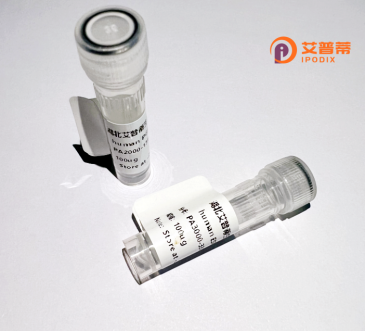
| 纯度 | >90%SDS-PAGE. |
| 种属 | Human |
| 靶点 | RCC1 |
| Uniprot No | P18754 |
| 内毒素 | < 0.01EU/μg |
| 表达宿主 | E.coli |
| 表达区间 | 2-421 aa |
| 活性数据 | SPKRIAKRR SPPADAIPKS KKVKVSHRSH STEPGLVLTL GQGDVGQLGL GENVMERKKP ALVSIPEDVV QAEAGGMHTV CLSKSGQVYS FGCNDEGALG RDTSVEGSEM VPGKVELQEK VVQVSAGDSH TAALTDDGRV FLWGSFRDNN GVIGLLEPMK KSMVPVQVQL DVPVVKVASG NDHLVMLTAD GDLYTLGCGE QGQLGRVPEL FANRGGRQGL ERLLVPKCVM LKSRGSRGHV RFQDAFCGAY FTFAISHEGH VYGFGLSNYH QLGTPGTESC FIPQNLTSFK NSTKSWVGFS GGQHHTVCMD SEGKAYSLGR AEYGRLGLGE GAEEKSIPTL ISRLPAVSSV ACGASVGYAV TKDGRVFAWG MGTNYQLGTG QDEDAWSPVE MMGKQLENRV VLSVSSGGQH TVLLVKDKEQ S |
| 分子量 | 44.9 kDa |
| 蛋白标签 | His tag N-Terminus |
| 缓冲液 | PBS, pH7.4, containing 0.01% SKL, 1mM DTT, 5% Trehalose and Proclin300. |
| 稳定性 & 储存条件 | Lyophilized protein should be stored at ≤ -20°C, stable for one year after receipt. Reconstituted protein solution can be stored at 2-8°C for 2-7 days. Aliquots of reconstituted samples are stable at ≤ -20°C for 3 months. |
| 复溶 | Always centrifuge tubes before opening.Do not mix by vortex or pipetting. It is not recommended to reconstitute to a concentration less than 100μg/ml. Dissolve the lyophilized protein in distilled water. Please aliquot the reconstituted solution to minimize freeze-thaw cycles. |
以下为重组人RCC1蛋白相关的3-4篇代表性文献信息简列(作者、标题及摘要概要):
1. **"RCC1: A regulator of chromosome condensation"**
*作者:Ohtsubo, M. et al. (1987)*
**摘要概要**:首次发现并命名了RCC1(Regulator of Chromosome Condensation 1),证明其通过调控Ran GTPase活性参与染色体结构维持和细胞周期进程。
2. **"The structure of the RCC1 protein, a regulator of chromosome condensation"**
*作者:Renault, L. et al. (1998)*
**摘要概要**:解析了RCC1的晶体结构,揭示其七叶片β-propeller结构域,阐明了其与Ran蛋白结合的分子基础及在核转运中的作用机制。
3. **"Recombinant human RCC1 protein binds to chromatin and regulates nucleotide exchange of Ran GTPase"**
*作者:Nemergut, M.E. et al. (2001)*
**摘要概要**:报道重组RCC1蛋白的表达纯化方法,验证其在体外与染色质结合的能力,并证实其作为RanGEF激活Ran GTPase的催化功能。
4. **"RCC1-dependent interphase nuclear matrix controls mitotic entry in mammalian cells"**
*作者:Hutchins, J.R. et al. (2004)*
**摘要概要**:利用重组RCC1蛋白研究其在细胞周期调控中的作用,发现RCC1通过维持核基质完整性影响有丝分裂进入的时序。
*注:以上文献可通过PubMed或Sci-Hub等平台查询原文。*
Regulator of Chromosome Condensation 1 (RCC1), a highly conserved eukaryotic protein, plays a critical role in cell cycle regulation and chromatin organization. Discovered in the 1980s, RCC1 serves as the primary guanine nucleotide exchange factor (GEF) for the small GTPase Ran, catalyzing the conversion of RanGDP to RanGTP. This activity establishes the RanGTP gradient across the nuclear envelope, which is essential for nucleocytoplasmic transport, mitotic spindle assembly, and post-mitotic nuclear envelope reformation. RCC1 binds directly to chromatin through its interaction with histones and DNA, preferentially associating with regions of high guanine-cytosine (GC) content and specific histone modifications.
Structurally, RCC1 contains a seven-bladed β-propeller fold formed by tandem repeats of a "RCC1-like" domain. This unique architecture enables its dual function: anchoring to chromatin while facilitating Ran binding and nucleotide exchange. Recombinant human RCC1 protein, typically expressed in *E. coli* or insect cell systems, has been instrumental in dissecting these biochemical mechanisms. Studies using purified RCC1 have revealed its oscillating chromatin affinity during the cell cycle and its role in maintaining mitotic fidelity. Dysregulation of RCC1 is linked to genomic instability and cancer progression, with emerging roles in viral pathogenesis and DNA repair pathways. Its recombinant form remains a key tool for investigating nuclear-cytoplasmic communication and cell cycle-targeted therapies.
×